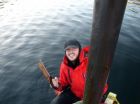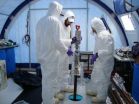(Press-News.org) The stems of shrubs have given researchers a window into a glacier's past, potentially allowing them to more accurately assess how they're set to change in the future.
Their findings have been published today, 27 November, in IOP Publishing's journal Environmental Research Letters, and show how a glacier's history of melting can be extended way past the instrumental record.
Much like the rings on a tree stump indicate how old it is, measuring the width of rings on the stem of a shrub can give a good indication of how well it has grown year on year. Under extreme environmental conditions, such as those close to a glacier, a shrub's growth relies heavily on summer temperatures, meaning the ring-width of a shrub can be used a proxy for glacial melting, which also relies heavily on summer temperatures.
Lead author of the study, Allan Buras, said: "In warm summers, shrubs grow more compared to cold summers. In contrast, a glacier's summer mass balance is more negative in warm summers, meaning there is more melting compared to cold summers.
"Big rings in shrubs therefore indicate comparably warm summers, and thus a strongly negative summer mass balance – in other words, more melting."
The researchers, from the University of Greifswald, tested this theory on a local icecap in the Scandic Mountains of southern Norway. They took 24 samples of shrubs from a site close to the glacier and analysed their ring-widths.
Monthly precipitation and temperature data from a local climate station were retrieved from the Norwegian Meteorological Office, and the summer mass balance of the glacier, from 1963 to 2010, was retrieved from the existing literature.
Each of these data sets was then statistically tested to see if there was a correlation between them. The results showed a robust and reliable correlation between the ring-width of shrubs and the summer melting of the glacier.
"Our results show that it is possible to reconstruct glacier summer mass balance with shrub ring-width series and it is therefore theoretically possible to extent records of summer mass balance into the past," Buras continued.
The shrubs that were collected in the study were relatively young, only allowing for reliable reconstructions over the past 36 years, meaning they could not be used to extend the record of the glacier; however, the researchers are confident that this could have been achieved if longer-lived shrubs were selected.
Most of the available data on the mass balance of glaciers only spans several decades and there is some data missing, mainly because most glaciers are situated in hard-to-reach arctic and alpine areas.
With the possibility to extend the instrumental records of summer mass balance, researchers may gain a better understanding of how glaciers behave in the summer, which they can use to calibrate and verify their existing models.
From Tuesday 27 November, this paper can be downloaded from http://iopscience.iop.org/1748-9326/7/4/044031/article
###
Notes to Editors
Contact
1. For further information, a full draft of the journal paper or contact with one of the researchers, contact IOP Press Officer, Michael Bishop:
Tel: 0117 930 1032
E-mail: Michael.bishop@iop.org
Can shrubs help to reconstruct glacier retreats?
2. The published version of the paper 'Can shrubs help to reconstruct glacier retreats?' (Allan Buras et al 2012 Environ. Res. Lett. 7 044031) will be freely available online from Tuesday 27 November. It will be available at http://iopscience.iop.org/1748-9326/7/4/044031/article.
Environmental Research Letters
3. Environmental Research Letters is an open access journal that covers all of environmental science, providing a coherent and integrated approach including research articles, perspectives and editorials.
IOP Publishing
4. IOP Publishing provides publications through which leading-edge scientific research is distributed worldwide. IOP Publishing is central to the Institute of Physics (IOP), a not-for-profit society. Any financial surplus earned by IOP Publishing goes to support science through the activities of IOP. Beyond our traditional journals programme, we make high-value scientific information easily accessible through an ever-evolving portfolio of community websites, magazines, conference proceedings and a multitude of electronic services. Focused on making the most of new technologies, we're continually improving our electronic interfaces to make it easier for researchers to find exactly what they need, when they need it, in the format that suits them best. Go to http://ioppublishing.org/.
The Institute of Physics
5. The Institute of Physics is a leading scientific society. We are a charitable organisation with a worldwide membership of more than 45,000, working together to advance physics education, research and application. We engage with policymakers and the general public to develop awareness and understanding of the value of physics and, through IOP Publishing, we are world leaders in professional scientific communications.
Shrubs lend an insight into a glacier's past
2012-11-27
ELSE PRESS RELEASES FROM THIS DATE:
Scientists image brain structures that deteriorate in Parkinson's
2012-11-27
CAMBRIDGE, MA -- A new imaging technique developed at MIT offers the first glimpse of the degeneration of two brain structures affected by Parkinson's disease.
The technique, which combines several types of magnetic resonance imaging (MRI), could allow doctors to better monitor patients' progression and track the effectiveness of potential new treatments, says Suzanne Corkin, MIT professor emerita of neuroscience and leader of the research team. The first author of the paper is David Ziegler, who received his PhD in brain and cognitive sciences from MIT in 2011.
The ...
Using biomarkers from prehistoric human feces to track settlement and agriculture
2012-11-27
For researchers who study Earth's past environment, disentangling the effects of climate change from those related to human activities is a major challenge, but now University of Massachusetts Amherst geoscientists have used a biomarker from human feces in a completely new way to establish the first human presence, the arrival of grazing animals and human population dynamics in a landscape.
Doctoral student Robert D'Anjou and his advisor Raymond Bradley, director of the Climate System Research Center at UMass Amherst, with UMass colleagues Nick Balascio and David Finkelstein, ...
This week's forecast: Sunny with a 40 percent chance of flu
2012-11-27
NEW YORK (November 26, 2012)—Scientists have developed a system to predict the timing and severity of seasonal influenza outbreaks that could one day help health officials and the general public better prepare for them. The system adapts techniques used in modern weather prediction to turn real-time, Web-based estimates of influenza infection into local forecasts of seasonal flu.
Results appear online in the Proceedings of the National Academy of Sciences.
Year to year, and region to region, there is huge variability in the peak of flu season, which, in temperate areas ...
New hope for setback-dogged cancer treatment
2012-11-27
Several drugs companies have ineffectively tried to produce antibodies that bind to the IGF-1 receptor on the cell surface, which has a critical part to play in the development of cancer. Scientists at Karolinska Institutet in Sweden have now ascertained how these antibodies work, and can explain why only some cancer patients are helped by IGF-1 blockers during clinical tests. The researchers also present a means by which drugs of this kind could help more cancer patients.
Every cell contains thousands of tiny receptors that help it communicate with other cells. These ...
Ancient microbes found living beneath the icy surface of Antarctic lake
2012-11-27
RENO – This week a pioneering study published in the Proceedings of the National Academy of Sciences (PNAS) and co-authored by Dr. Alison Murray and Dr. Christian Fritsen of Nevada's Desert Research Institute (DRI) reveals, for the first time, a viable community of bacteria that survives and ekes out a living in a dark, salty and subfreezing environment beneath nearly 20 meters of ice in one of Antarctica's most isolated lakes.
Lake Vida, the largest of several unique lakes found in the McMurdo Dry Valleys, contains no oxygen, is mostly frozen and possesses the highest ...
Possible new treatment for Ewing sarcoma
2012-11-27
SALT LAKE CITY— Discovery of a new drug with high potential to treat Ewing sarcoma, an often deadly cancer of children and young adults, and the previously unknown mechanism behind it, come hand-in-hand in a new study by researchers from Huntsman Cancer Institute (HCI) at the University of Utah. The report appears in today's online issue of the journal Oncogene.
"Ewing sarcoma is almost always caused by a cancer-causing protein called EWS/FLI," said Stephen Lessnick, M.D., Ph.D., director of HCI's Center for Children's Cancer Research, professor in the Department of ...
Bioengineered marine algae expands environments where biofuels can be produced
2012-11-27
Biologists at UC San Diego have demonstrated for the first time that marine algae can be just as capable as fresh water algae in producing biofuels.
The scientists genetically engineered marine algae to produce five different kinds of industrially important enzymes and say the same process they used could be employed to enhance the yield of petroleum-like compounds from these salt water algae. Their achievement is detailed in a paper published online in the current issue of the scientific journal Algal Research.
The ability to genetically transform marine algae into ...
Students at cooperative schools are more engaged
2012-11-27
This press release is available in Spanish.
Student engagement is not independent of the type of school attended.Nor is it independent of the organisational development of the school.The school's organisational style affects the work of its teaching staff, which, in turn, has repercussions on the performance and engagement of their students.As IkerRos, the UPV/EHU researcher, has been able to verify in his PhD thesis, these factors vary when comparing public schools, subsidised schools and co-operative schools, the latter being the ones that fare best.
"The study of ...
Dramatic rise in autism prevalence parallels research explosion
2012-11-27
(NEW YORK, N.Y., November 26, 2012) – Autism Speaks Chief Science Officer Geraldine Dawson, Ph.D. describes how the dramatic progress in autism research has paralleled increased recognition of autism's prevalence and financial impact in the December issue of the Archives of General Psychiatry published on line today. "This issue of the journal features three articles on autism," she writes in her editorial. "A decade ago, the journal published about the same number of autism articles per year."
Dr. Dawson also notes that, while the funding for autism research has dramatically ...
University of Maryland School of Medicine, NIH study pinpoints brain area's role in learning
2012-11-27
An area of the brain called the orbitofrontal cortex is responsible for decisions made on the spur of the moment, but not those made based on prior experience or habit, according to a new basic science study from substance abuse researchers at the University of Maryland School of Medicine and the National Institute on Drug Abuse (NIDA). Scientists had previously believed that the area of the brain was responsible for both types of behavior and decision-making. The distinction is critical to understanding the neurobiology of decision-making, particularly with regard to substance ...



